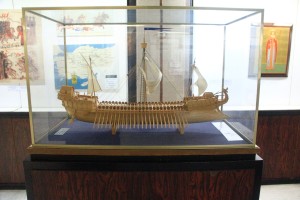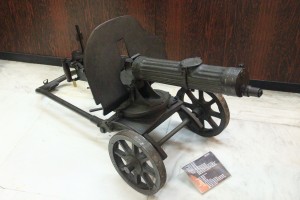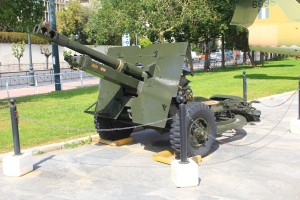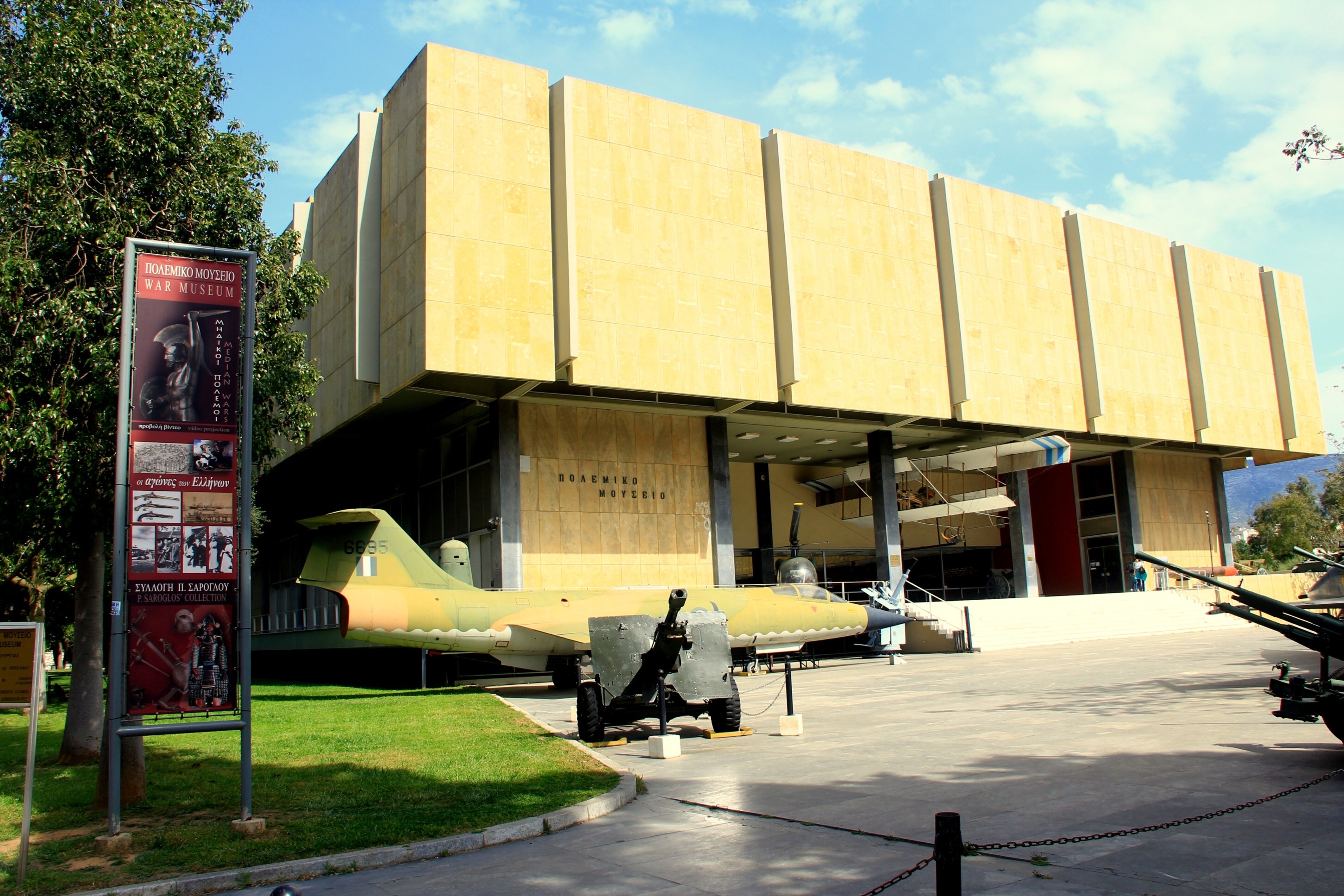
By Tim Campbell
About a half mile from Syntagma Square, the heartbeat of Athens, Greece, sits the giant Athens War Museum, covering 3000 years of military history. This must-visit museum for military history aficionados and militaria fans features four floors of ancient warfare, ranging from the ancient times of Alexander the Great right through to World War II.
Torn by millennia of conflict, Greece has witnessed innumerable battles. Battles it has won and lost against nation states like Macedonia, the Ottoman Empire, Italy and Germany. Funded by grants from the Greek armed forces and generous donations from individuals and companies, the Athens War Museum is loved by all visitors with even the slightest interest in military history and warfare.
My guide during my recent visit, Brigadier General Panagiotis Kaperonis, is a 37-year veteran of the Greek Army. Now 55 years old, Brigadier General Kaperonis was educated at the world famous Gordonstoun Academy in Scotland, and also spent time training at Fort Benning near Atlanta, Georgia, USA. Gordonstoun Academy is where Prince Charles went to school.
Designed by scientists, and headed by Professor Thoukidides Valentis, the Athens war museum was built in 1975 and opened that year by the then Greek Minister of Defense, Constantine Tsatsos. This year the museum celebrates its 40th anniversary.
This bastion of all things military covers approximately 40,000 square feet, with four floors and a parking garage. An outside area, open to the public, is crammed with First and Second World War artillery and aircraft. The striking outdoor exhibition space displays Army, Navy and Air force militaria, including a helicopter, fighter jets, eighteenth century cannons, and several generations of artillery.
All the outdoor exhibits are being restored by professionals. When one is completed and returned to the museum, another departs. Each unit takes approximately two to three months for full restoration, the cost supported by grants from the Greek armed forces, depending on which military division the piece is from.
Inside, as we move from floor to floor, Brig.Gen. Kaperonis describes the various wars and battles that his Hellenic nation has been involved with over the centuries. He told me, “The lower floor is understandably the most popular with overseas visitors because it showcases the exploits of Greece’s most famous son and greatest legend, Alexander the Great”.
The lower floor contains many copies of priceless relics, the originals being stored in the National Museum next to the Acropolis. There are however, some rare original pieces, such as ancient Greek headgear, displayed in glass cases. These are at least two thousand years old, and some even older. The bronze Corinthian, Hoplite, and Spartan helmets were worn by soldiers dating from the Fifth century B.C.
Other interesting artifacts from the period of Alexander the Great include a crossbow and flamethrower. The crossbows were converted into giant-sized military hardware and fired at the enemy, no doubt bringing down several soldiers with each strike of their huge and formidable bolts.

During sea battles, the crossbow arrows were set alight with pitch and fired at oncoming vessels. Another surprising weapon was the flamethrower. Pitch was set alight in a bronze barrel and blown by bellows against the enemy by ramming an end spike into the opposing ship. Pushing the bellows that blew air into the tube and through holes in the end, allowed the flames to set fire to the enemy’s wooden vessels. One wonders how many ships delivering the flame were accidentally set on fire!
Setting advancing ships on fire with these ancient flamethrowers was a tactic that made Alexander the Great victorious at sea on many occasions. His soldiers would also convert flamethrowers into hand held units that were used to set fire to masses of infantry and buildings. Models of these crossbows and flamethrowers, and the rock hurling catapults, can be seen in glass cases on the ground floor.
Other artifacts from the Persian, Peloponnesian, and Spartan wars can be viewed under glass covers. The underground floor also houses many prehistoric relics found during archaeological excavations in the city. Dating back to the Neolithic period, the priceless pieces of flint, obsidian and bone are housed in special cases to protect them from today’s temperatures and dust.
Many other pieces date back to the Bronze Age, featuring items from the Minoan, Cycladic and Mycenaean civilizations. However, many of these are copies of the originals from the National museum at the Acropolis. Despite this, I thought this museum would be practically a religious experience for followers of Homer’s Odyssey!
The main floor with the entrance has a dual purpose. Showcases displaying World War II uniforms and glass cases are packed full of medals, ribbons and emblems detailing various Greek armed forces over the centuries. The small arms hardware galleries are set up in various parts of the rectangular main floor with models of artillery and transport used in World War II. This is also where entry tickets are purchased.
A central atrium on the first floor exhibits statues of famous Greek figures from centuries of Greek history. These sculptures of Generals and mythical characters really bring this central atrium to life. The atrium’s marvelous open air design encourages visitors to wander and take the time to view each statue. Informational plaques describe each protagonist’s place in Greece’s volatile history.

The first floor features hardware from World War One and the Balkan Wars. Comprised of small arms and models, these exhibits give the viewer a sense of the portability of the pieces. The lighter mortars and cannon, along with howitzers and 75mm guns, proved to be indispensible artillery in the mountain battles between the Greeks and their attackers. These portable pieces allowed the armies to move around and above their invaders in the mountains, and fire down upon them with devastating effect.
The second (top) floor features hardware from the Second World War and scale models of various battles and naval vessels. Visitors from the U.K. will recognise the British uniforms and the numerous samples of British military hardware. As one of Greece’s staunchest allies over the centuries Britain has helped provide the Hellenic armies with funds and equipment, as well as uniforms for the Army, Navy, and Air Force.
Many of the pieces on display from WW2 were from captured enemy positions. They include German machine guns and Italian mortars and rifles. The WW1 items such as the rifles, artillery and Mauser machine guns were purchased from the Austrian Hungarian Empire but not with money or traded, they were bought with tons of tobacco grown in Greece.
Greece was devastated during the Second World War. As well as having the majority of Greek Jews being exterminated, the country suffered heavily losing 400,000 of its 4 million then inhabitants, almost 1 in 10 of the entire population. Many Greeks went overseas to both the USA and the UK, helping the war effort by returning funds and weapons to Greece from abroad.
While occupied by the Nazis, Greek partisans fought their battles mainly in the mountains until liberated by the Russians in October 1944. Scale models of some of these World War II battles can be seen in glass cases, the main feature being a replica of the famous Metaxas line of 19 forts across the north of Greece. The small arms display features Lee Enfield rifles, German Mauser guns, Italian mortars and other handguns and rifles.

On display in the exterior exhibition are both jet aircraft and helicopters from the Air Force, and Navy sonar equipment. Anti tank weaponry can be seen outside as well as 16th century cannons, 75mm howitzers, rapid fire pom-pom guns, aircraft bombs and missiles. Brig.Gen. Kaperonis gave me detailed information on the items explaining his love of the infantry and how important the artillery was to them. He told me “Without the artillery the infantry cannot be effective, and vice versa”.
The Athens war museum is a highlight for any military veteran, and entry to the museum is only three Euros. To be able to see this much historical hardware through the centuries of Greek history for the price of an ice cream is great value.
People with a military background or anyone who just enjoys looking at original military equipment, can feast their eyes on this original collection found nowhere else in the world. It is an unforgettable experience for any trip to Athens.
Athens War Museum, Rizari 2, Athens. Open 9am to 6pm, closed on Mondays. Smoking is not allowed and there are no facilities to purchase food or drinks. The website for more information is www.warmuseum.gr/english/ and the telephone number of the museum is 210-7252974. If you’d like to meet Brigadier General Kaperonis or arrange a personal tour, contact info@warmuseum.gr.

